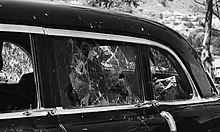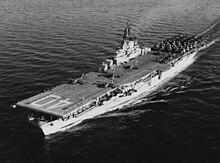
Richard Milhous Nixon was the 37th president of the United States, serving from 1969 to 1974. A member of the Republican Party, he previously served as a representative and senator from California and as the 36th vice president from 1953 to 1961 under President Dwight D. Eisenhower. His presidency saw the reduction of U.S. involvement in the Vietnam War, détente with the Soviet Union and China, the Apollo 11 Moon landing, and the establishment of the Environmental Protection Agency and Occupational Safety and Health Administration. Nixon's second term ended early when he became the only U.S. president to resign from office, as a result of the Watergate scandal.

The 1956 United States presidential election was the 43rd quadrennial presidential election. It was held on Tuesday, November 6, 1956. Incumbent Republican President Dwight D. Eisenhower and his running mate, incumbent Vice President Richard Nixon, were re-elected, defeating for a second time Democrat Adlai Stevenson II, former Illinois governor. This election was the sixth rematch in American presidential history, a situation which would not occur again until 2024. It was the second time in which the winner was the same both times, the first being William McKinley's victories over William Jennings Bryan in 1896 and 1900. This was the last election before term limits established by the 22nd Amendment, which applied to Eisenhower, were effective.

Henry Cabot Lodge Jr. was an American diplomat and politician who represented Massachusetts in the United States Senate and served as United States Ambassador to the United Nations in the administration of President Dwight D. Eisenhower. In 1960, he was the Republican nominee for Vice President on a ticket with Richard Nixon, who had served two terms as Eisenhower's vice president. The Republican ticket narrowly lost to Democrats John F. Kennedy and Lyndon B. Johnson; Lodge later served as a diplomat in the administrations of Kennedy, Johnson, Nixon, and Gerald Ford and was a presidential contender in 1964.
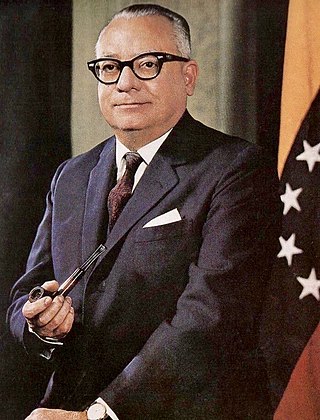
Rómulo Ernesto Betancourt Bello, known as "The Father of Venezuelan Democracy", was the president of Venezuela, from 1945 to 1948 and again from 1959 to 1964, as well as leader of Acción Democrática, Venezuela's dominant political party in the 20th century.

José María Hipólito Figueres Ferrer served three terms as President of Costa Rica: 1948–1949, 1953–1958 and 1970–1974. During his first term in office he abolished the country's army, nationalized its banking sector, granted women and Afro-Costa Ricans the right to vote, and offered Costa Rican nationality to people of African descent.
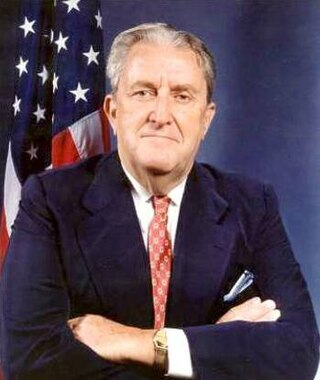
Vernon Anthony Walters was a United States Army officer and a diplomat. Most notably, he served from 1972 to 1976 as Deputy Director of Central Intelligence, from 1985 to 1989 as the United States Ambassador to the United Nations and from 1989 to 1991 as Ambassador to the Federal Republic of Germany during the decisive phase of German Reunification. Walters rose to the rank of lieutenant general in the U.S. Army and is a member of the Military Intelligence Hall of Fame.

Douglas MacArthur II was an American diplomat. During his diplomatic career, he served as United States ambassador to Japan, Belgium, Austria, and Iran, as well as Assistant Secretary of State for Legislative Affairs. He was the nephew of the U.S. general Douglas MacArthur.

United States–Venezuela relations have traditionally been characterized by an important trade and investment relationship as well as cooperation in combating the production and transit of illegal drugs.
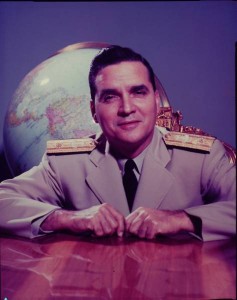
Rear Admiral Wolfgang Enrique Larrazábal Ugueto was a Venezuelan naval officer and politician. He served as President of Venezuela following the overthrow of Marcos Pérez Jiménez in the 23 January 1958 Venezuelan coup d'état, standing down later that year.

Dwight D. Eisenhower's tenure as the 34th president of the United States began with his first inauguration on January 20, 1953, and ended on January 20, 1961. Eisenhower, a Republican from Kansas, took office following his landslide victory over Democratic nominee Adlai Stevenson in the 1952 presidential election. Four years later, in the 1956 presidential election, he defeated Stevenson again, to win re-election in a larger landslide. Eisenhower was limited to two terms and was succeeded by Democrat John F. Kennedy, who won the 1960 presidential election.
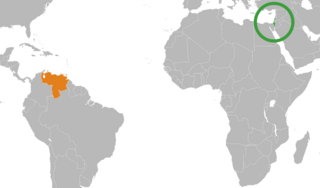
Israeli–Venezuelan relations refer to foreign relations between Israel and Venezuela. Both countries have no formal relations since 2009. Canada serves as Israel's protecting power in Venezuela through its embassy in Caracas, while Spain serves as Venezuela's protecting power in Israel through its embassy in Tel Aviv.

Relations between Cuba and Venezuela were established in 1902. The relationship deteriorated in the 1960s and Venezuela broke relations in late 1961 following the Betancourt Doctrine policy of not having ties with governments that had come to power by non-electoral means. A destabilizing factor was the Cuban support for the antigovernment guerrilla force that operates in remote rural areas. Venezuela broke off relations with Cuba after the Machurucuto invasion in 1967, when Cuban trained guerrillas landed in Venezuela seeking to recruit guerrillas and overthrow the government of Raúl Leoni. Relations were reestablished in 1974.

Six Crises is the first book written by Richard Nixon, who later became the 37th president of the United States. It was published in 1962, and it recounts his role in six major political situations. Nixon wrote the book in response to John F. Kennedy's Pulitzer Prize–winning Profiles in Courage, which had greatly improved Kennedy's public image.
A military dictatorship ruled Venezuela for ten years, from 1948 to 1958. After the 1948 Venezuelan coup d'état brought an end a three-year experiment in democracy, a triumvirate of military personnel controlled the government until 1952, when it held presidential elections. These were free enough to produce results unacceptable to the government, leading them to be falsified, and to one of the three leaders, Marcos Pérez Jiménez, assuming the Presidency. His government was brought to an end by the 1958 Venezuelan coup d'état which saw the advent of democracy, with a transition government under Admiral Wolfgang Larrazábal in place until the December 1958 elections. Prior to the elections, three of the main political parties signed up to the Punto Fijo Pact power-transition agreement.

The 1958 Venezuelan coup d'état took place on 23 January 1958, when the dictator Marcos Pérez Jiménez was overthrown.
Antisemitism in Venezuela has occurred throughout the history of the Jews in Venezuela. However, under the presidencies of both Hugo Chávez and Nicolás Maduro, allegations of antisemitism grew following actions and statements by the Venezuelan government, while also occurring in public incidents. The Bolivarian government would also use the words of "Jewish" and "Zionist" interchangeably in order to avoid accusations of antisemitism.

The Embassy of the United States in Caracas is a United States embassy that represents the United States in Caracas, Venezuela. The embassy provides assistance to American citizens and residents who live in Venezuela and issues visas to foreign nationals, who are Venezuelan and legal residents in Venezuela, who wish to visit or immigrate to the United States.

North Korea–Venezuela relations are relations between the Democratic People's Republic of Korea and the Bolivarian Republic of Venezuela. Venezuela is one of the five countries in Latin America that has an embassy of North Korea along with Brazil, Colombia, Cuba and Nicaragua. However, Venezuela is one of the only countries in the world that has a good relationship with both North and South Korea.
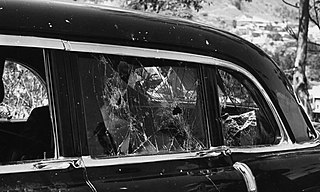
The following events occurred in May 1958:

H. Stuart Knight was the director of the United States Secret Service between 1973 and 1981. Prior to this position, Knight briefly worked as a police officer before he joined the United States Secret Service as a special agent in 1950. During his career, Knight was assigned to keep the president of the United States and vice president of the United States safe between 1951 and 1963. In this role, Knight protected the Vice President when the attack on Richard Nixon's motorcade occurred in 1958.





